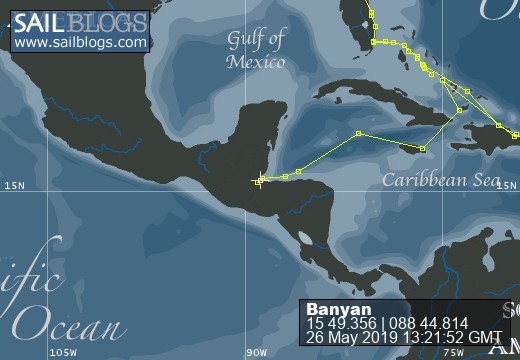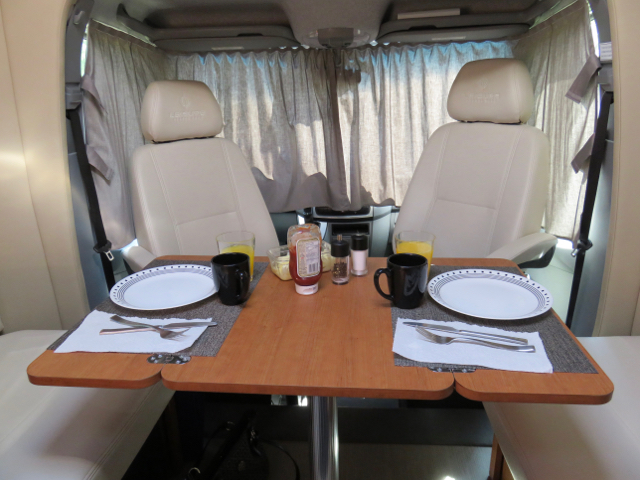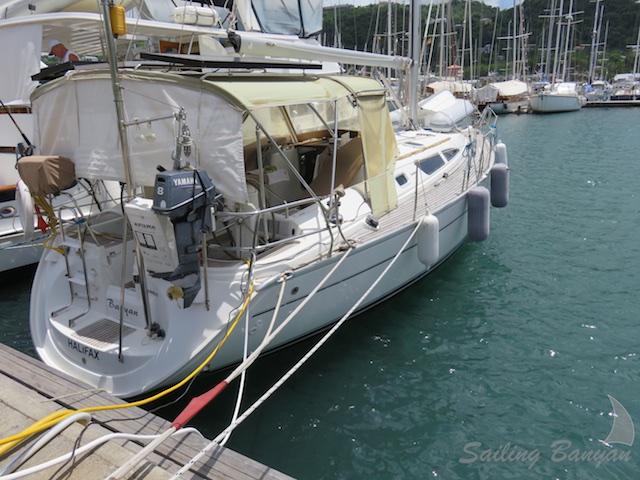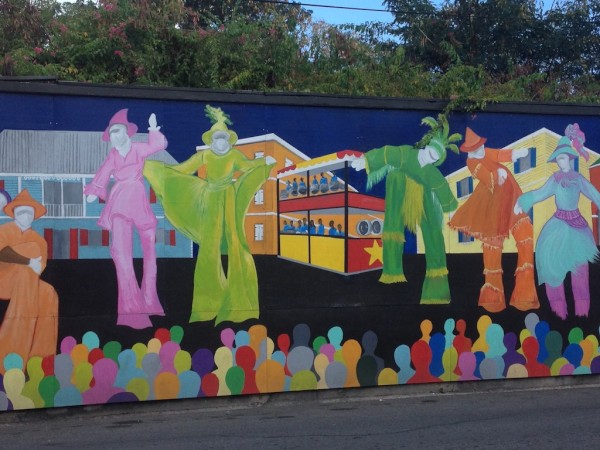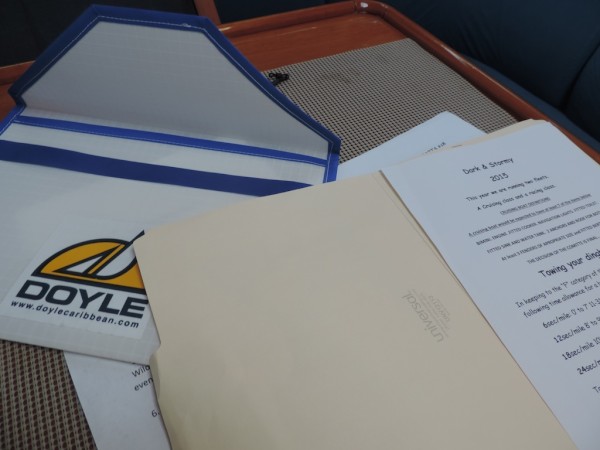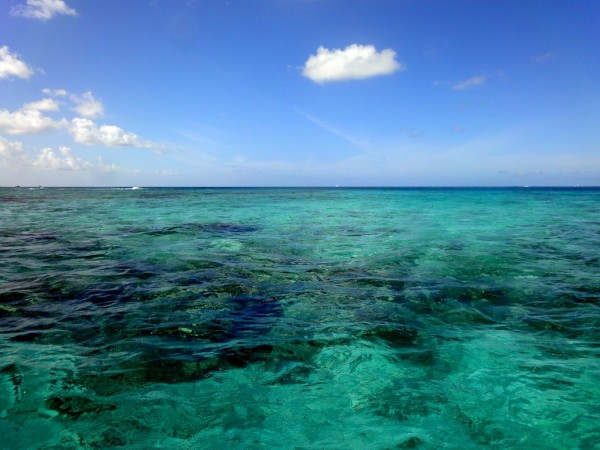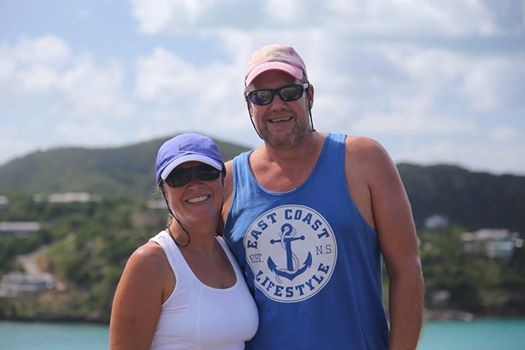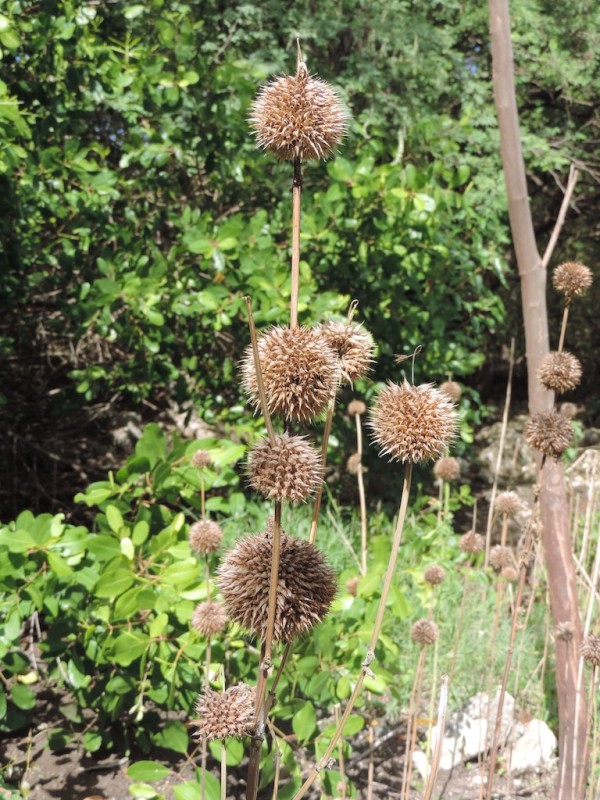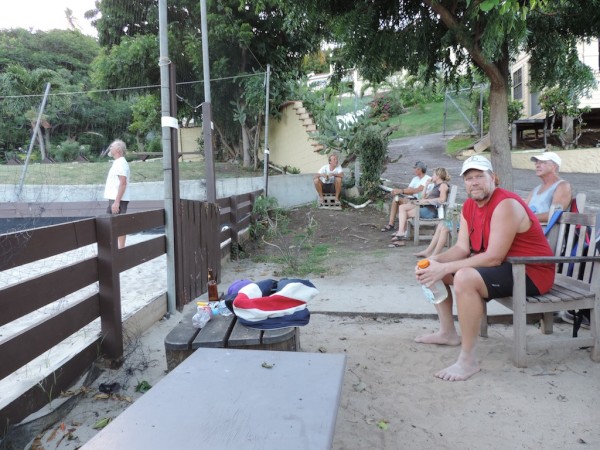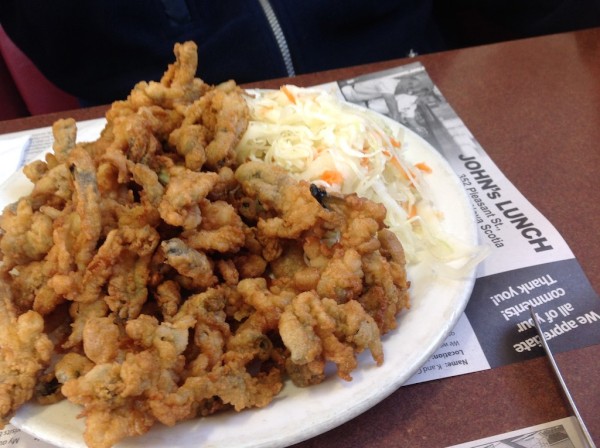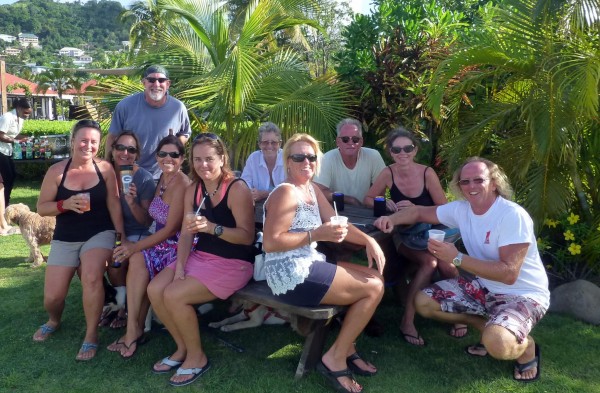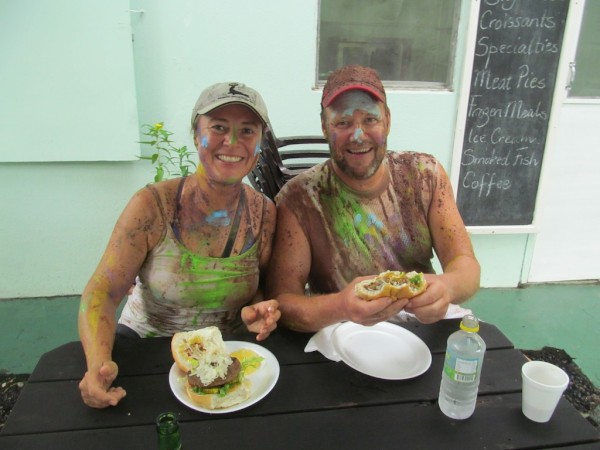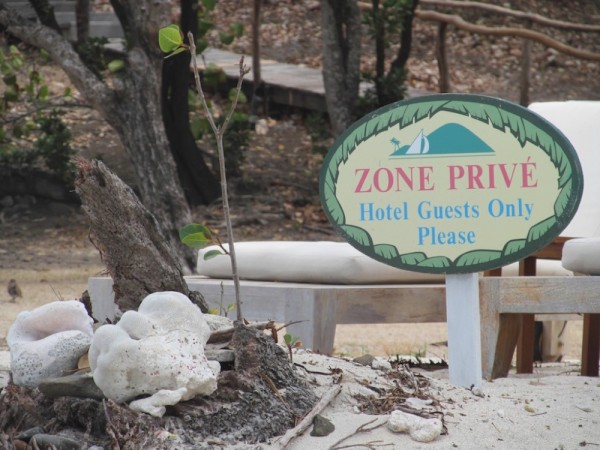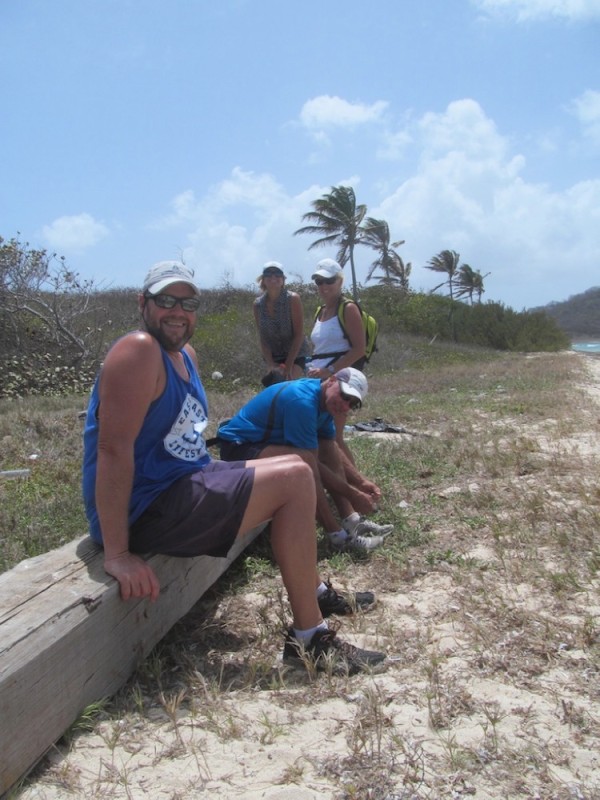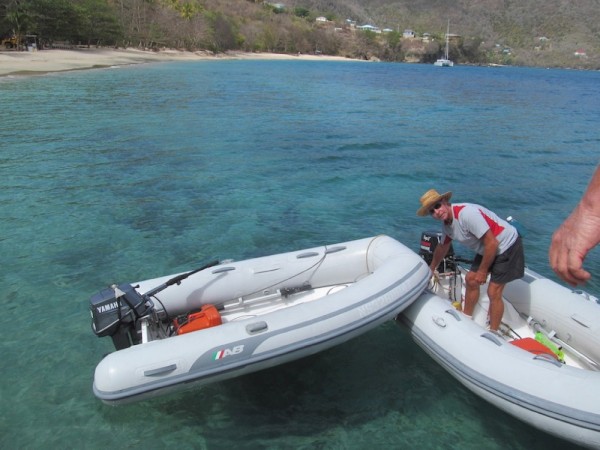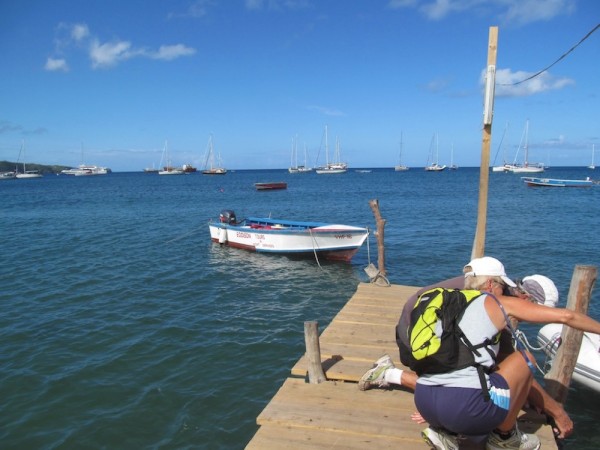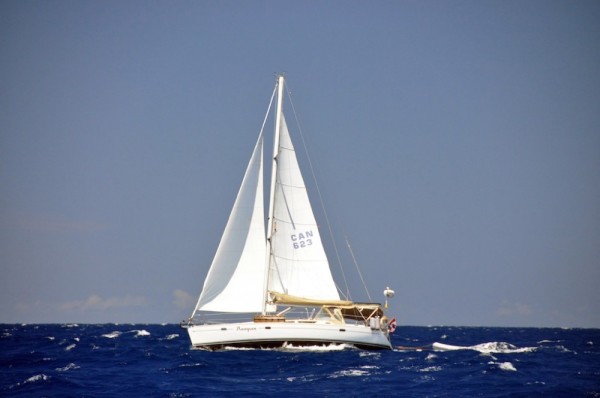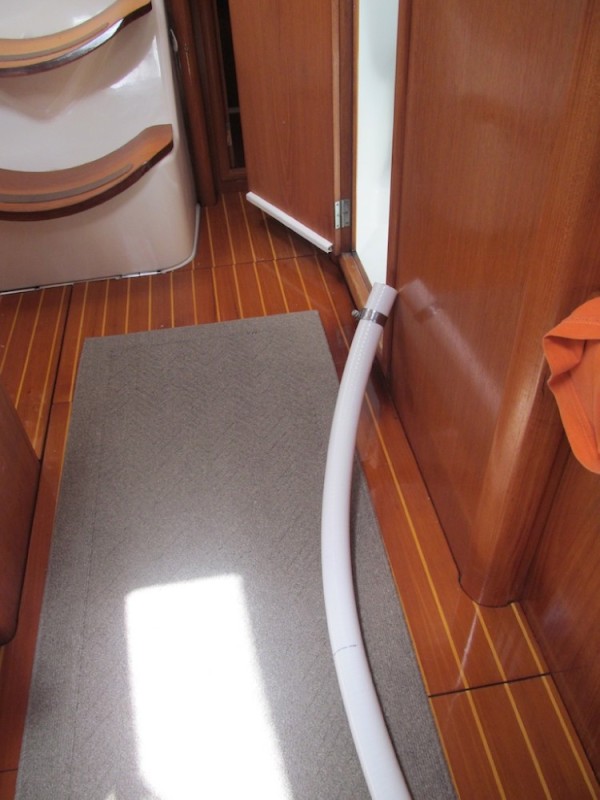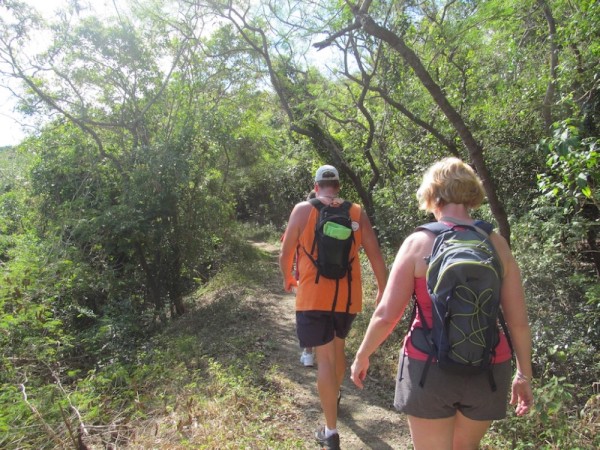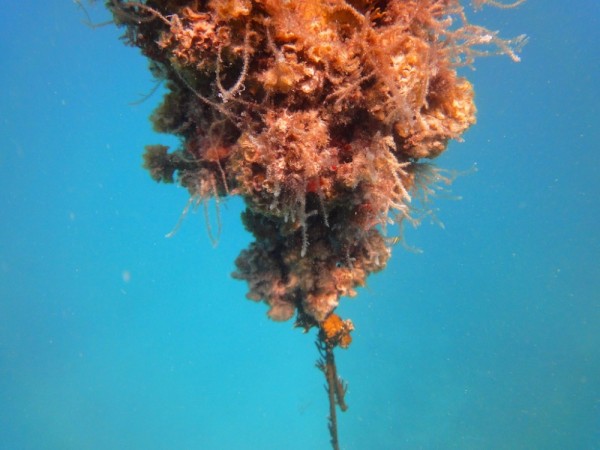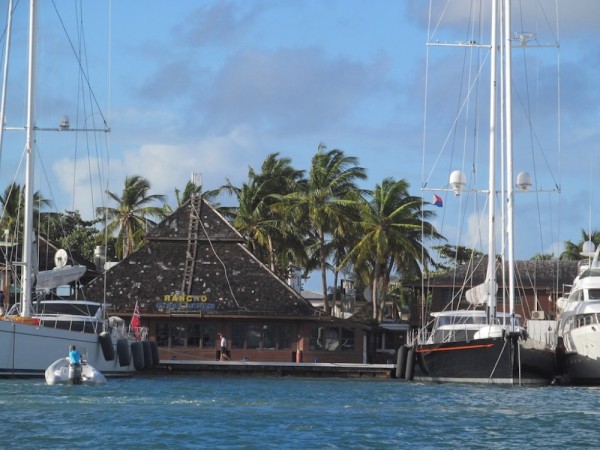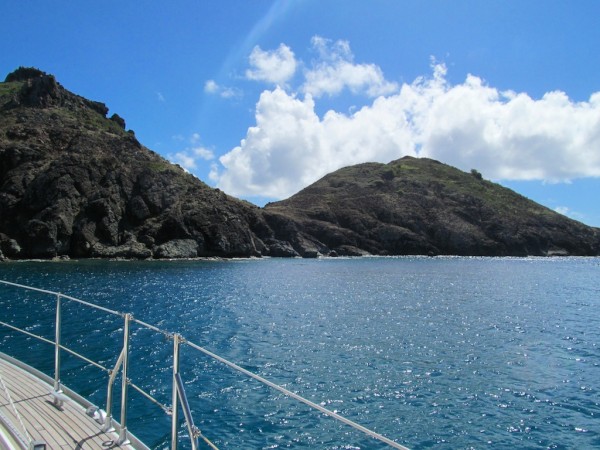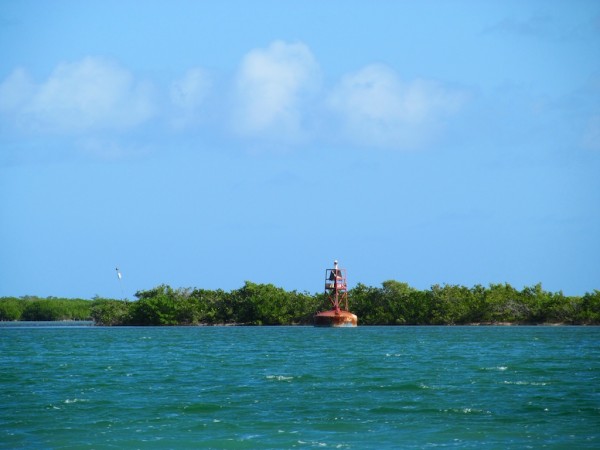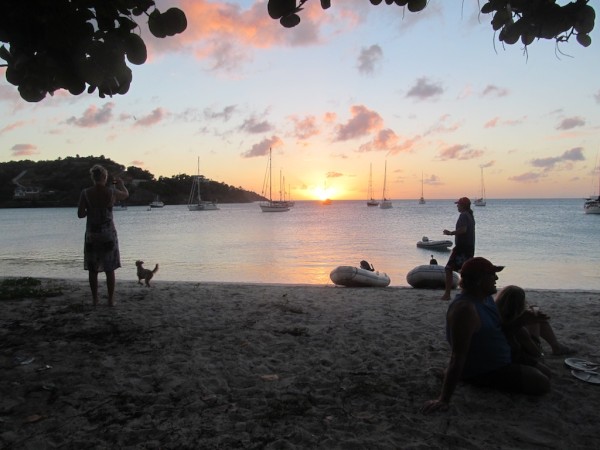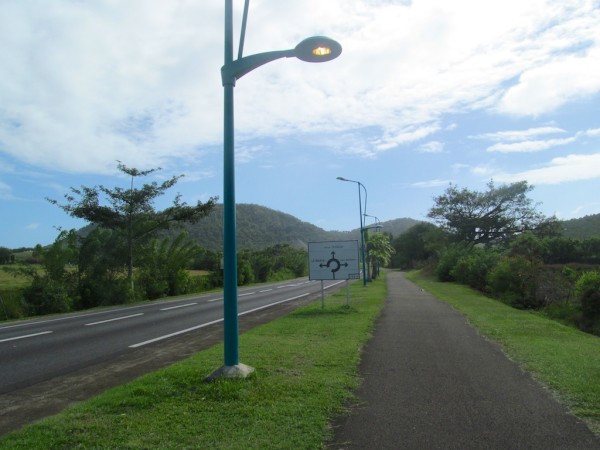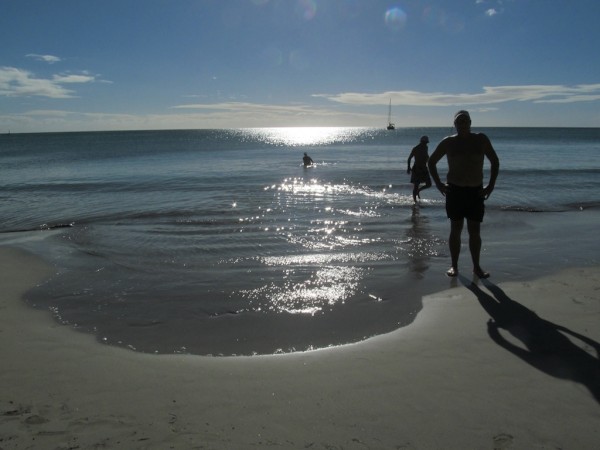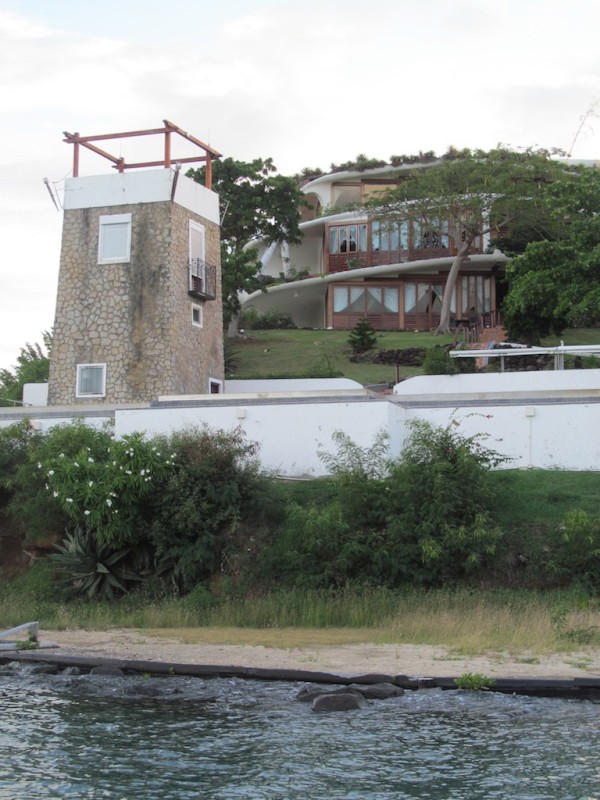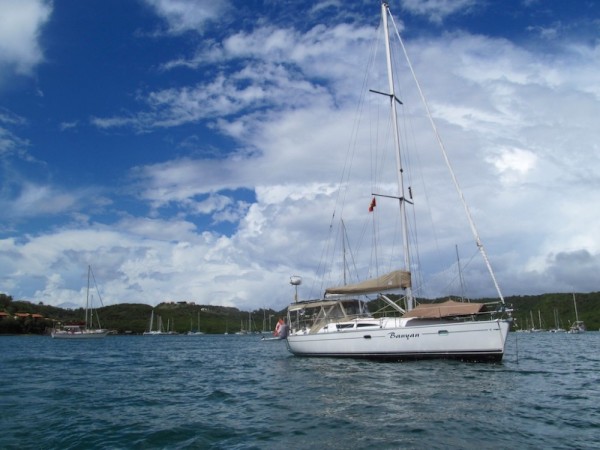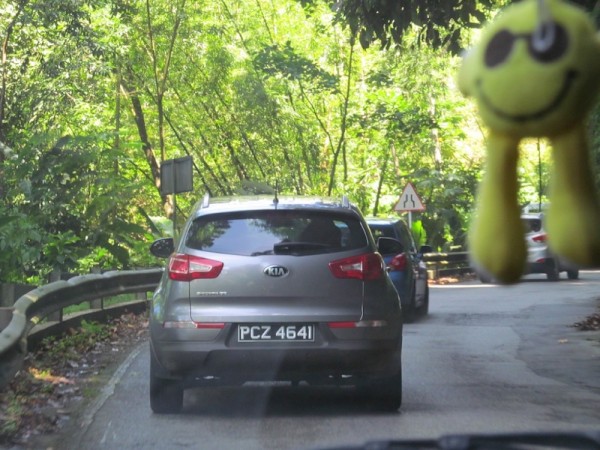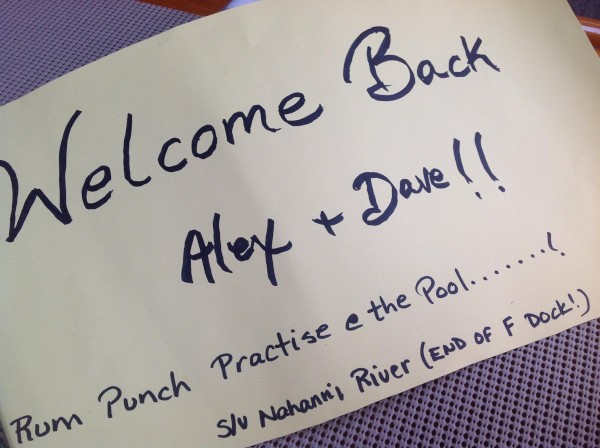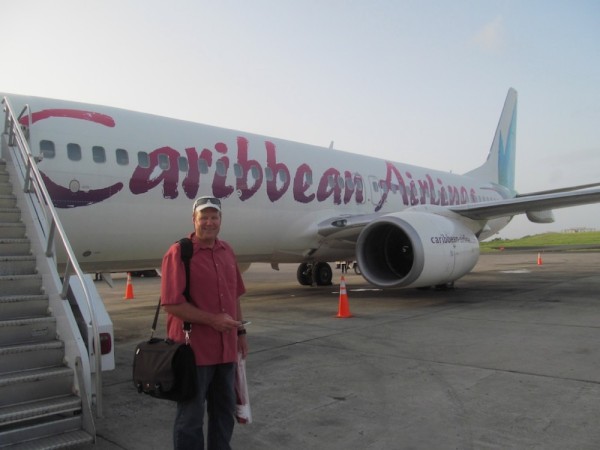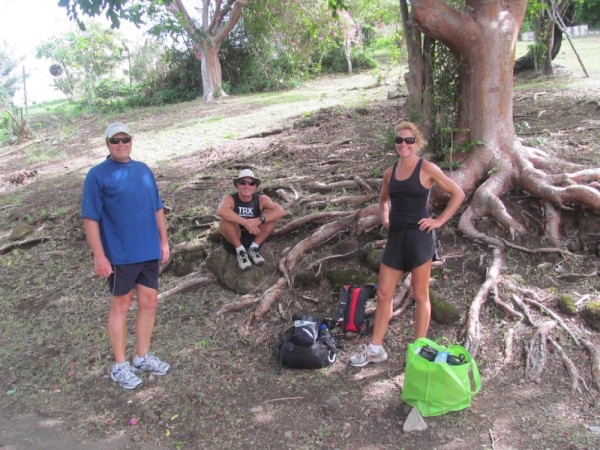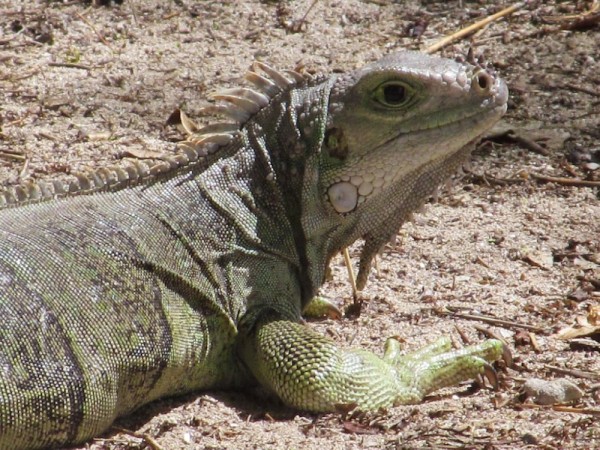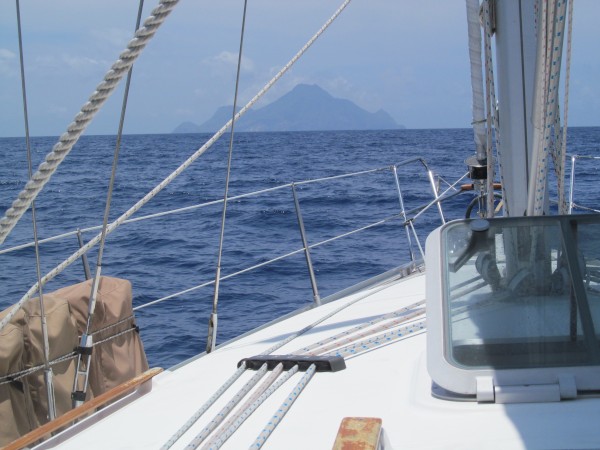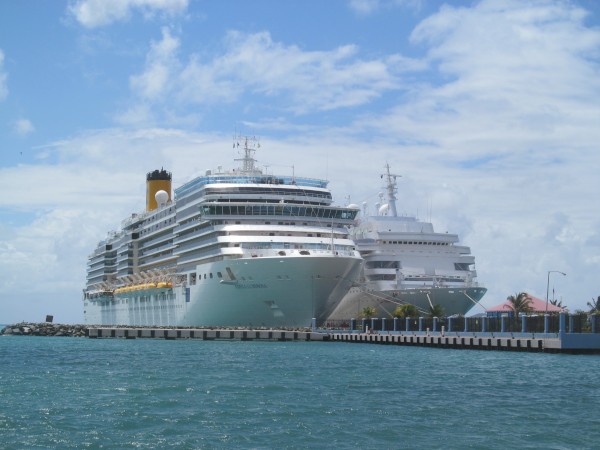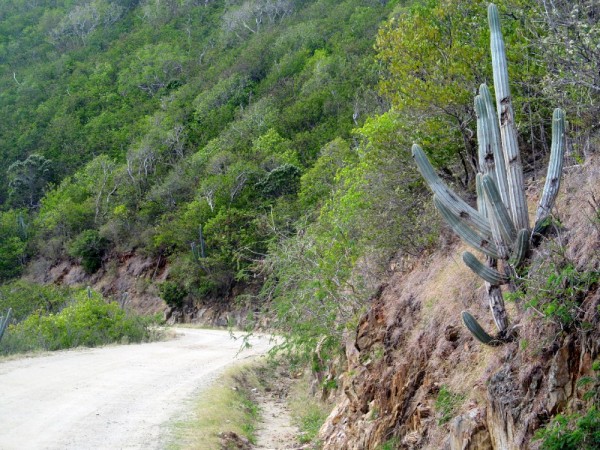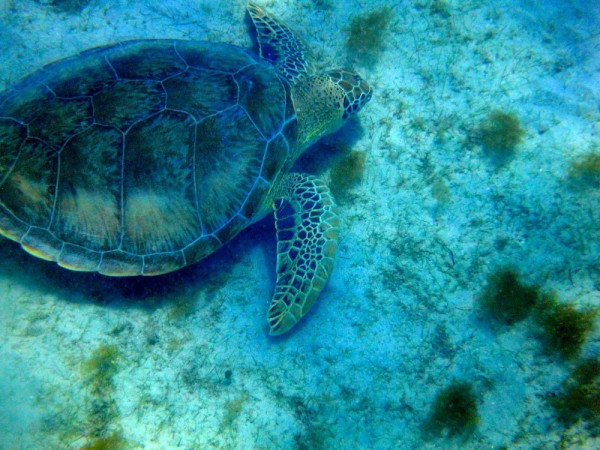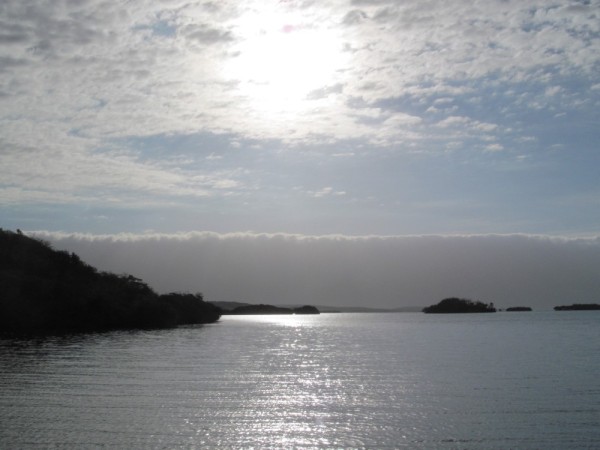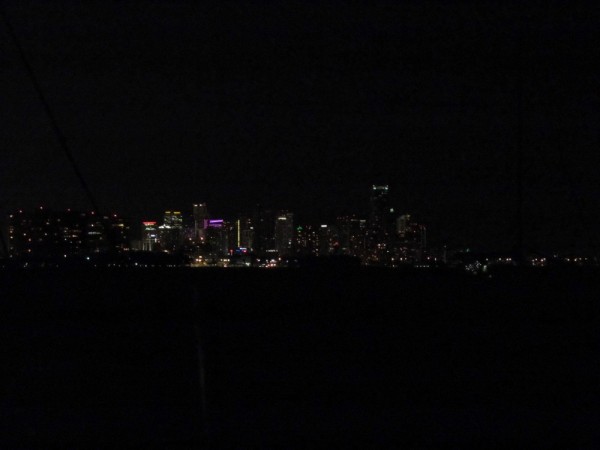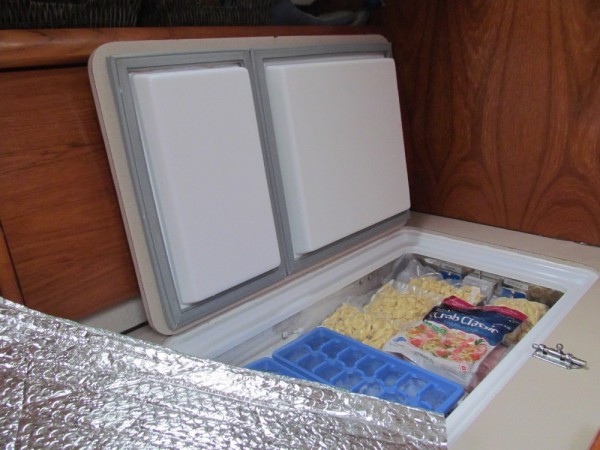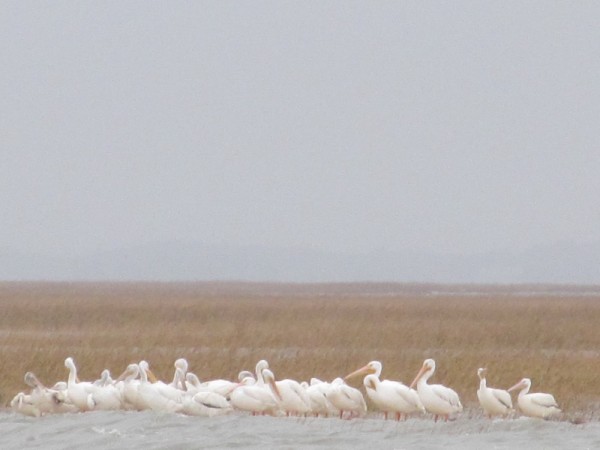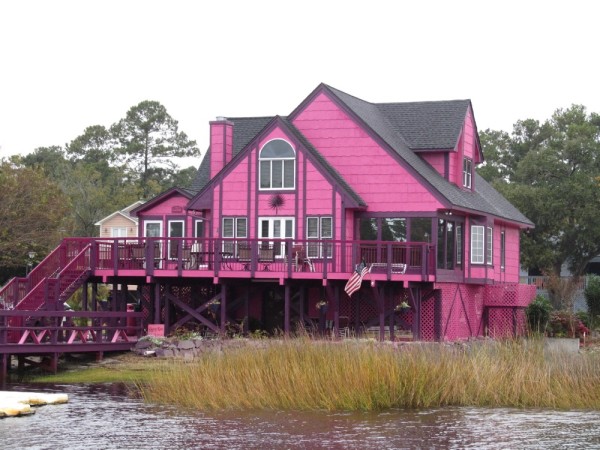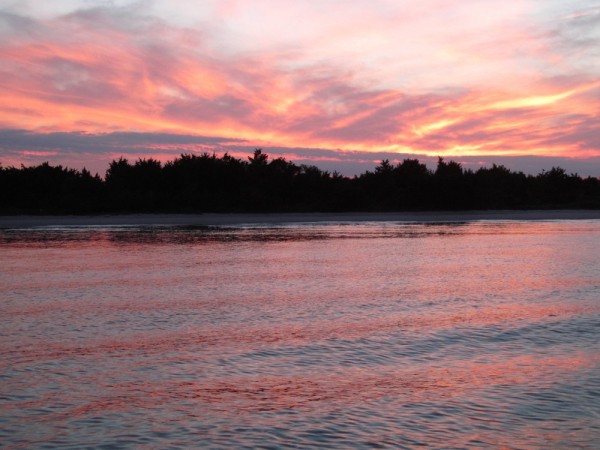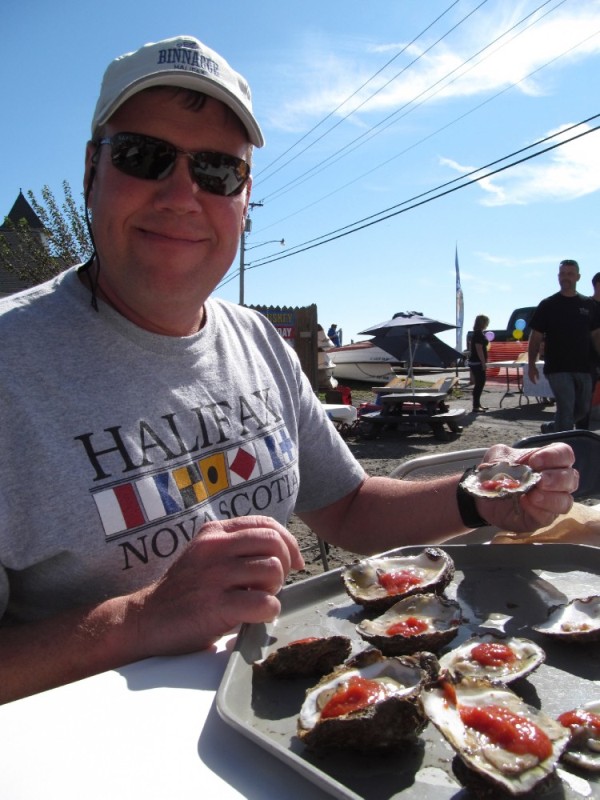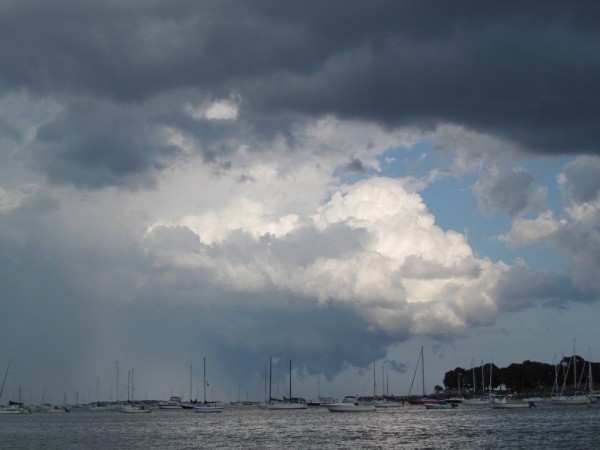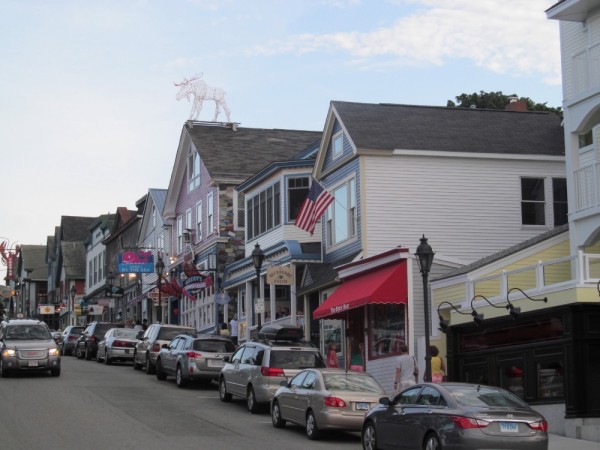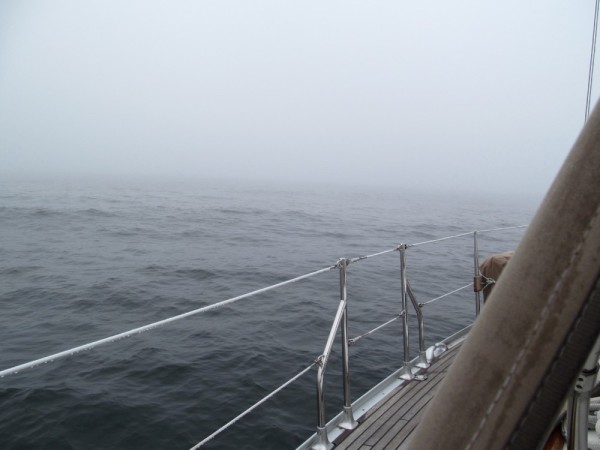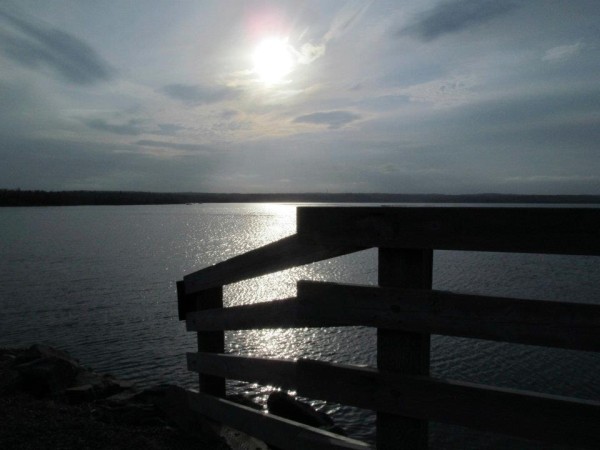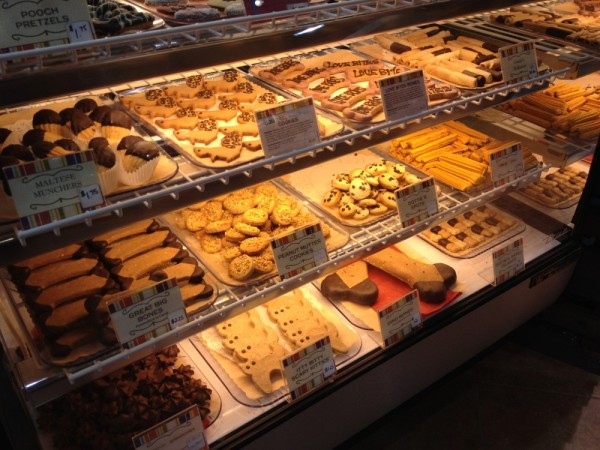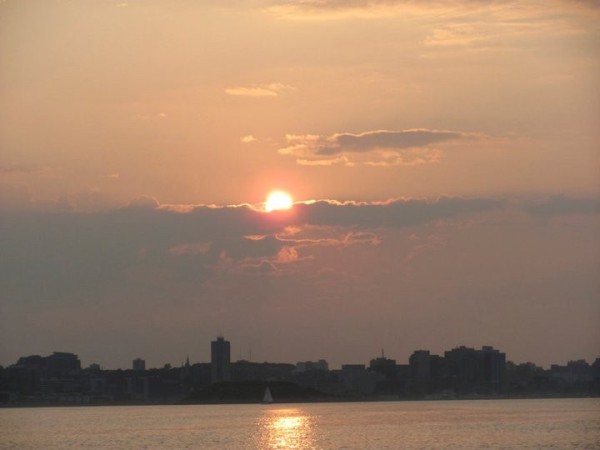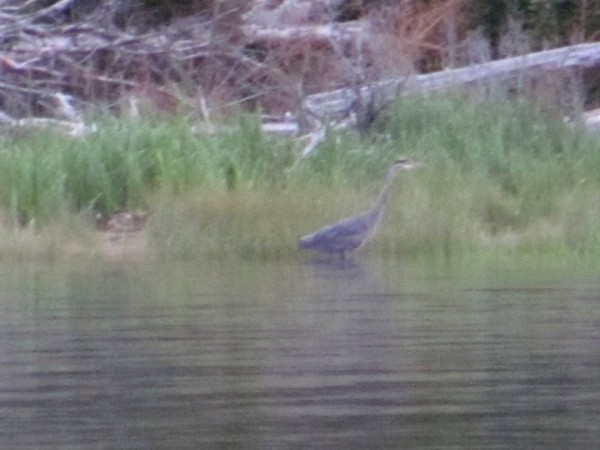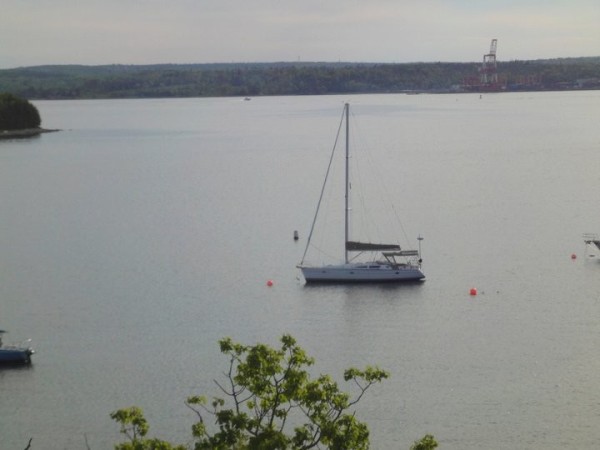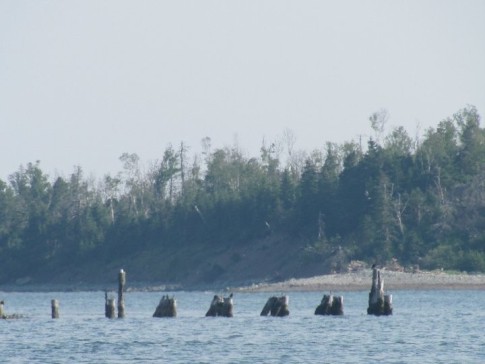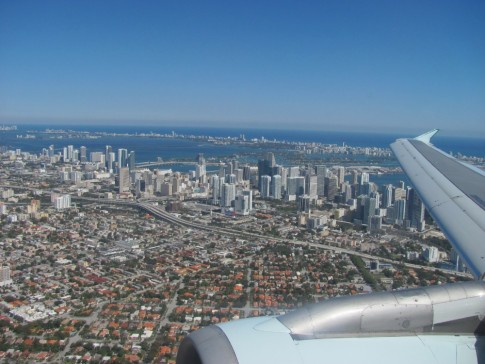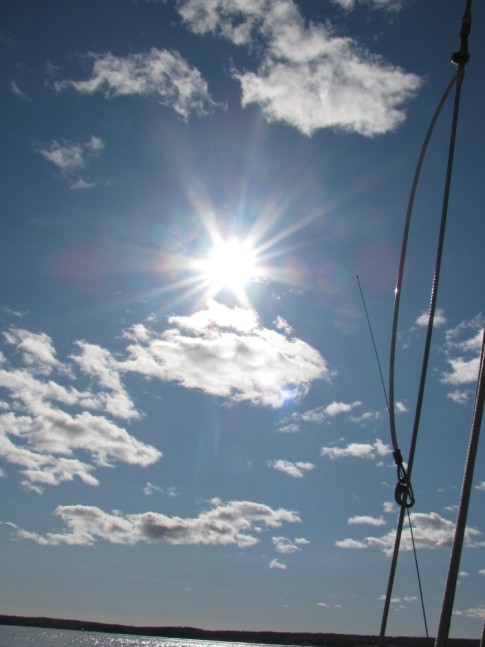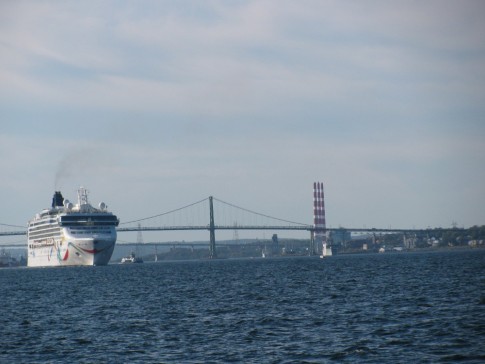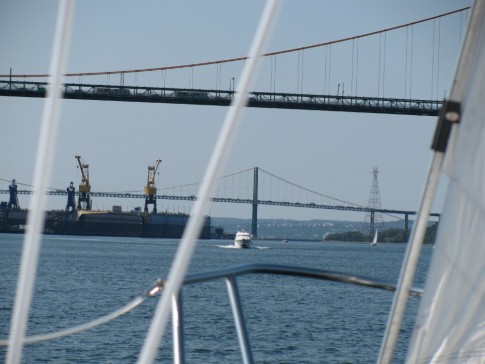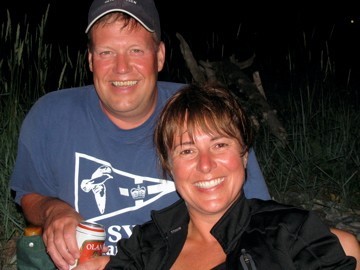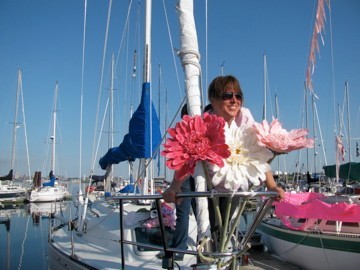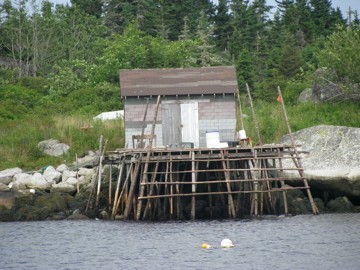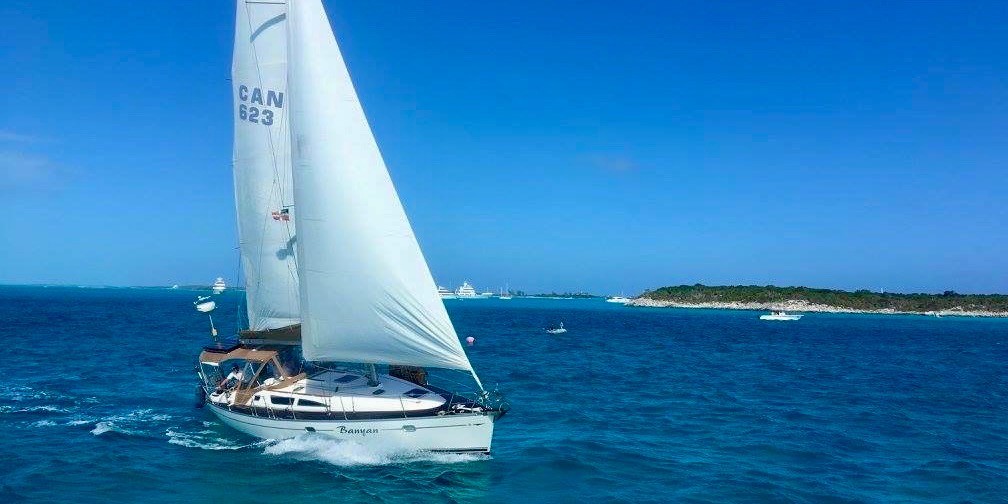
The Adventures of Alexandra and David

Who: David & Alexandra
Port: Halifax, Nova Scotia
Our Adventures Thus Far
Favorites
- Author - Rob Avery
- Amoray
- AnneCam
- Distant Shores
- Evening Ebb
- Harmony at Sea
- Jacobs Ladder
- Kathrian
- Lequesteau
- Modaki
- Sea Sparrow
- Shiloh
- Slow Waltz
- Spirit of Argo
- Strathspey
- SV Mowzer
- Troubador
- Turf to Surf
- Wandering Star
- Dos Libras
- Pacific Sailors
- Zero to Cruising
- BUMFUZZLE
- Madcap Sailing
- Silverheels lll
- Peregrine
- Windtraveler
We're always Somewhere South of Somewhere.
The Banyan Love is Growing.

WebPage Visits We're on Facebook Sailing Banyan

Instagram: #banyantravels but we're not Tweeting. Our friends Paul and Sheryl Shard, of Distant Shores, are incredible producers of their very own TV Show. If you haven't already, check them out.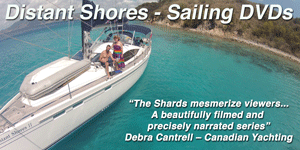 Their DVD's are informative and fun to watch as they travel to all four corners of the world.
You might even find Banyan in some of them!!
Their DVD's are informative and fun to watch as they travel to all four corners of the world.
You might even find Banyan in some of them!!
WebPage Visits We're on Facebook Sailing Banyan

Instagram: #banyantravels but we're not Tweeting. Our friends Paul and Sheryl Shard, of Distant Shores, are incredible producers of their very own TV Show. If you haven't already, check them out.
 Their DVD's are informative and fun to watch as they travel to all four corners of the world.
You might even find Banyan in some of them!!
Their DVD's are informative and fun to watch as they travel to all four corners of the world.
You might even find Banyan in some of them!! 23 March 2021 | Cole Harbour NS
30 May 2020
30 May 2019 | Catamaran Marina
20 May 2019 | Shallow Sandbar by Livingston, Guatemala
18 May 2019 | Tres Puntas, Guatemala
14 May 2019 | Isla Guanaja to Isla Utila
11 May 2019 | Grand Cayman to Isla de Guanaja, Honduras
03 May 2019 | Grand Cayman
25 April 2019 | Errol Flyn Marina, Port Antonio, Jamaica
24 April 2019
18 April 2019 | Matthewtown, Great Inagua, Bahamas
14 April 2019 | Clarencetown, Long Island, Bahamas
10 April 2019 | To New Horizons... and Beyond!
05 April 2019 | Exumas, Bahamas
02 March 2019 | Staniel Cay, Cat Island, Bahamas
07 February 2019 | Cambridge Cay, Exumas, Bahamas
25 August 2018 | Halifax, NS
28 November 2017 | Somewhere on the Atlantic Ocean
22 November 2017
The Great Big Tipping Incident
20 May 2019 | Shallow Sandbar by Livingston, Guatemala
David & Alexandra | Hot
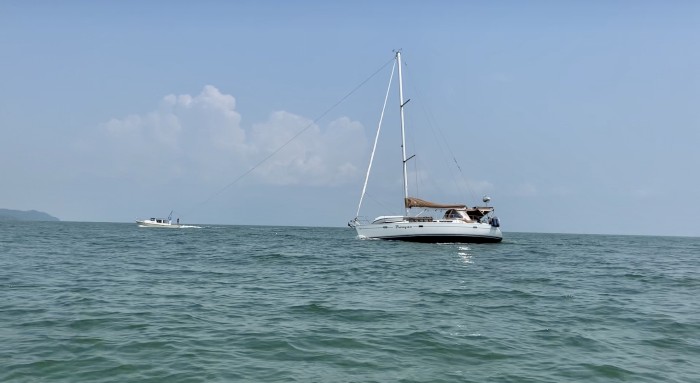
From the moment we decided that we were heading to the Western Caribbean, we knew we were sailing into, and hopefully over, an obstacle of the shallowest proportions.
Just before Livingston, where we would stop to clear in with Guatemalan Customs and Immigration, and just before the entrance to the Rio Dulce River, there exists the shallowest of a shifting sandbar. Crossing it with our 6'4" draft might be just a little... problematic.
"No Problem-Oh" said our friends, "there's people there who can tip you". Tip?
We looked at each other, squinting with eyes wide shut, with not quite a smile, and almost with a hint of a grimace. Being in and on your home while it's moving is one thing. Being in and on your home while it's moving, and being canted over while doing so, is not on anyone's comfort list. Challenging? You Bet. UnDoable? No, Many have gone before us, with Deeper Drafts than us, and survived to tell the tale! Nervous and Anxious? Hell yes!
We checked the Rio Dulce tide tables, looking for the dates for the highest of high tides happening in May.

Turns out May 18, 19 and 20th were our three days of options. On those dates we would have roughly, and at most, 1.9 feet of extra water over posted MLW depths. However, since the charts for this area were not all in agreement, {{so just how (in)accurate were they?? }}, we had no idea what we were dealing with. We chose May 19th as it listed the most water, until we looked at the calendar and realized that that day was a Sunday. A funday but not a working day. For C&I, or for Raul of Servamar and/or Hector Ramirez.
Our choices were then either Saturday or Monday and since a Sunday reunion with our friends in Tres Puntas was gathering momentum, we fixed our Big Crossing for Monday, 08:45 a.m. As much as no sailboat and cruiser ever wants to have a schedule, we now had ourselves {{ sigh }} a schedule. We had to get ourselves there for that date and time. What could possibly go wrong?
To bring you up to date: quite at the last minute we decided we would change course, so we got ourselves to Jamaica, on to Grand Cayman, then Ha!Ha! it was off to Guanaja! . On to Utila, and last but not least, we're in Tres Puntas.
So here we are.
It is Sunday night, the eve of the Big Crossing. A fun reunion on SV LivinLife allowed for much chit-chat and getting caught up, which is always an awesome time with friends, and that night it was no different. It also gave us the chance to meet many new cruisers.
As with all Sailing Stories, and especially Shallow Depth Crossing stories, listening to every one of them made us frown and feel like our depths made us a lost cause. Until we met a fellow Jeanneau owner, with a 7'something draft. "Pas de problèmes" he told us, "I've been crossing for the last few years and get tipped each and every time. I have an appointment at 08:30 with Hector. No worries mon ami, juste follow me", he said. Knowing someone was out there with more need to worry than us somehow spelled... relief.
Prior to this point we'd done as much research as we could. The facts of the crossing, as we knew them, were as follows:
There are no reliable charts for this area.
Mother Nature, climate and time have played havoc with the sandbar, making it quite the shifty piece of sand. So if, or rather when, you touch bottom, rumour has it that there is no need to worry. It really is just sludgy sand and chances are you will plow through it.
If, or rather when, you do bump bottom? Keep the revs on. You want and need speed and momentum to keep you going.
Weather is hard to predict months in advance so we didn't know what we were going to be experiencing the day of. If there's winds blowing, producing a 2 foot chop, well then chances are you'll bounce and hit even more than if conditions were calm. However, having wind might be a good thing, as it would allow you to out the jib, and produce a natural heel to aid in your crossing? Unlike the Bahamas, we didn't think the weather would be any shades of clear enough to spot and stay out of any shallow areas.
Water depths are dependant on time of year. How much has it rained recently? How active is the outflow of the Rio Dulce?
.png)
All reports are that it's an {{ easy }} bar crossing if you draw under 5.5. Anything over that should have you considering making the crossing at mid-to-high tide. We'd read that the maximum draft at high tide is 7.5 ft (2.20 m).
There is no marked channel, however there are few buoys out there. And there are several guiding waypoints floating around cyberspace.
Captain Freya Rauscher's waypoints are now, given time, weather and climate, considered old and rather inaccurate.
Different FB groups were providing some info, but one can never be sure, as some cruisers indicating "a no problem crossing" weren't providing any of their details (weather, tide, depth, draft...) which is always frustrating.
One boat had crossed the week prior and posted a new path with plenty of water depth. We were hopeful and intrigued.

Geoff on SV BlueJacket seemed to have spent quite some time with depth sounder in hand.
.png)
The whole event is only about 300-400 yards of unknown pucker factor conditions. That can seem like the longest {{ part of a }} mile though if you're bumping through it, or if you get stuck.
We had contacted Raul of Servamar to use as our agent for Guatemalan C&I procedures, and we'd e-mailed him our paperwork so he could start the process. At the same time, we made a request for Hector Ramirez to be on standby. We would try crossing on our own, but in all likelihood, would need some help of the heeling kind.
And last but not least, we had our friends. Who were going ahead of us, promising to read out the depths as they passaged through, providing much needed details of actual conditions.
It was a hot and hazy morning when we woke up the morning of the Big Crossing. We were well over a dozen boats in the Tres Puntas anchorage and we tried enjoying our coffee, but we were a little anxious and a lot excited.
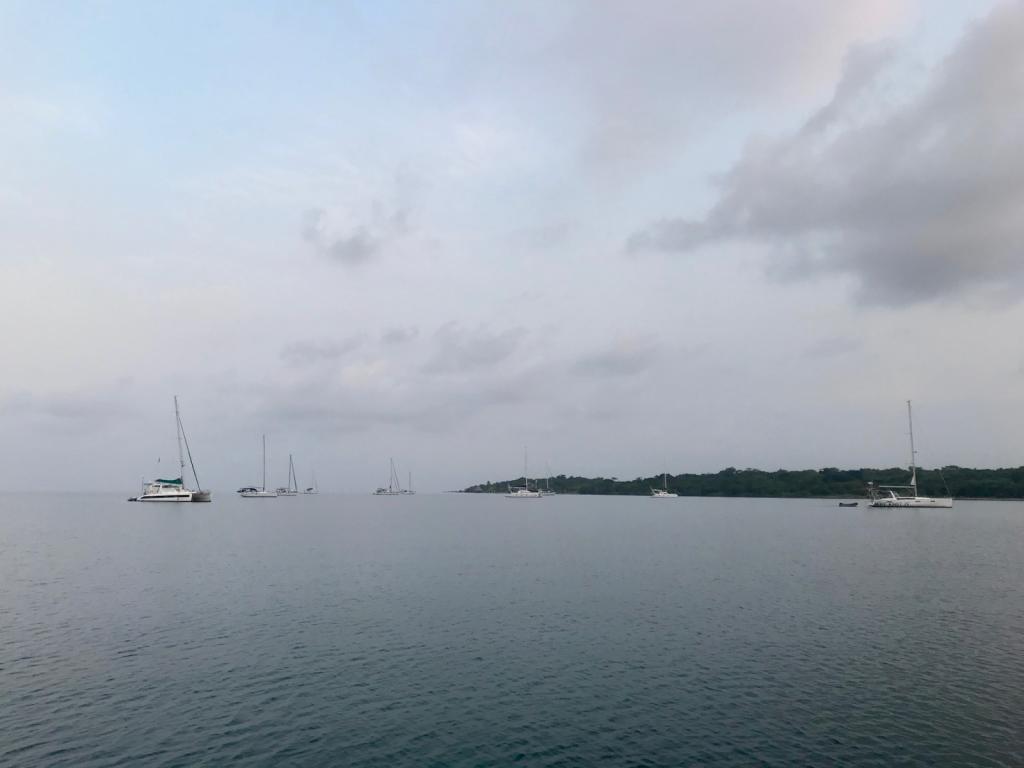
It was a short 10 nmile motor boat drive from Tres Puntas towards Livingston and in our excitement we left earlier than planned {{besides you want to get there BEFORE high tide }}, and were there before we even thought about a second cup of coffee.
And one by one the boats made their way across, the VHF crackling to life as the numbers were read. Two boats were trying SV Follow Me's waypoints, and then immediately reported "NoGo!", as water depths reached 4'9. Yikes!

No matter which depths I wrote down, one thing quickly became clear: there was just not enough water. We could try and plow our way through with one inch of sandy sludge, but not 6!

The question we then asked ourselves was: do we try on our own? Get stuck, then really need to get not only tipped, but towed as well? Or wait by the first marker and just get tipped as we drive Banyan across. For us, given the conditions at this moment in time, that was the better, safer and most sound option.
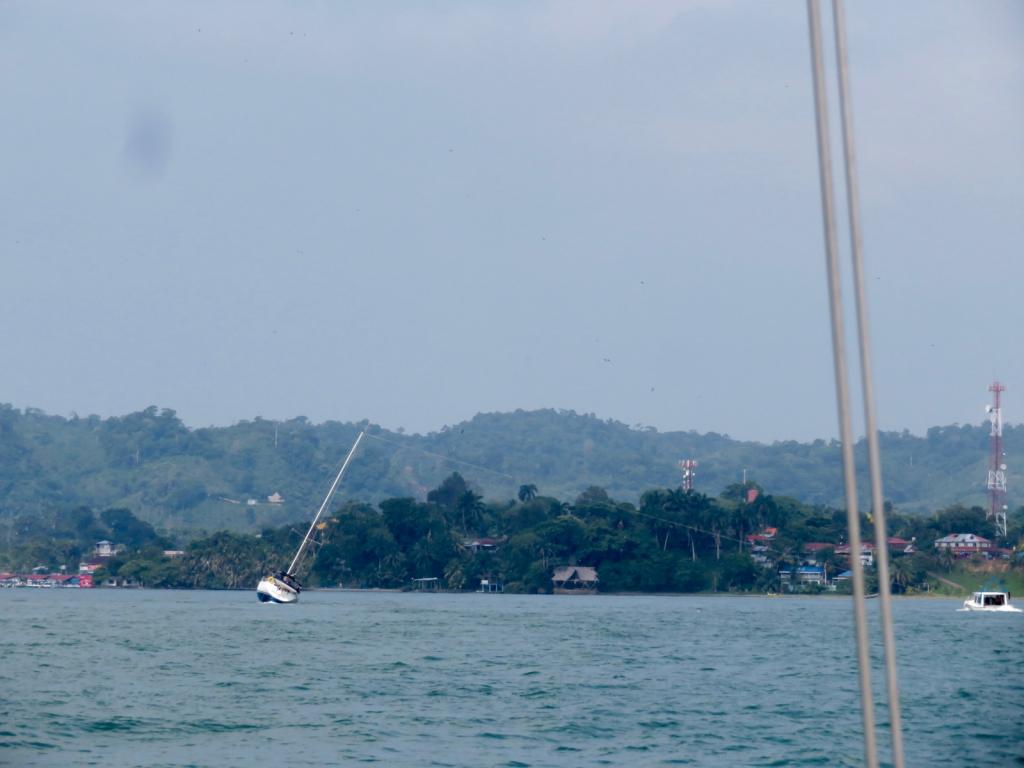
Unfortunately one of the boats ahead of us had gone way off course and was now heeled over, totally stuck in the sand. We saw Hector on his way towards the 08:30 appointment with the French Boat which was two boats over from us? Oops no. Hector turned around and stopped at the stuck boat. Looked like a bit of chit-chat was going on, and we saw the people on the boat looking for lines, running around, getting set up, finally handing their lines over to Hector and the tow boat. It took a few tries, and well over half hour to get her freed and dragged across.
It was now half hour past high tide.
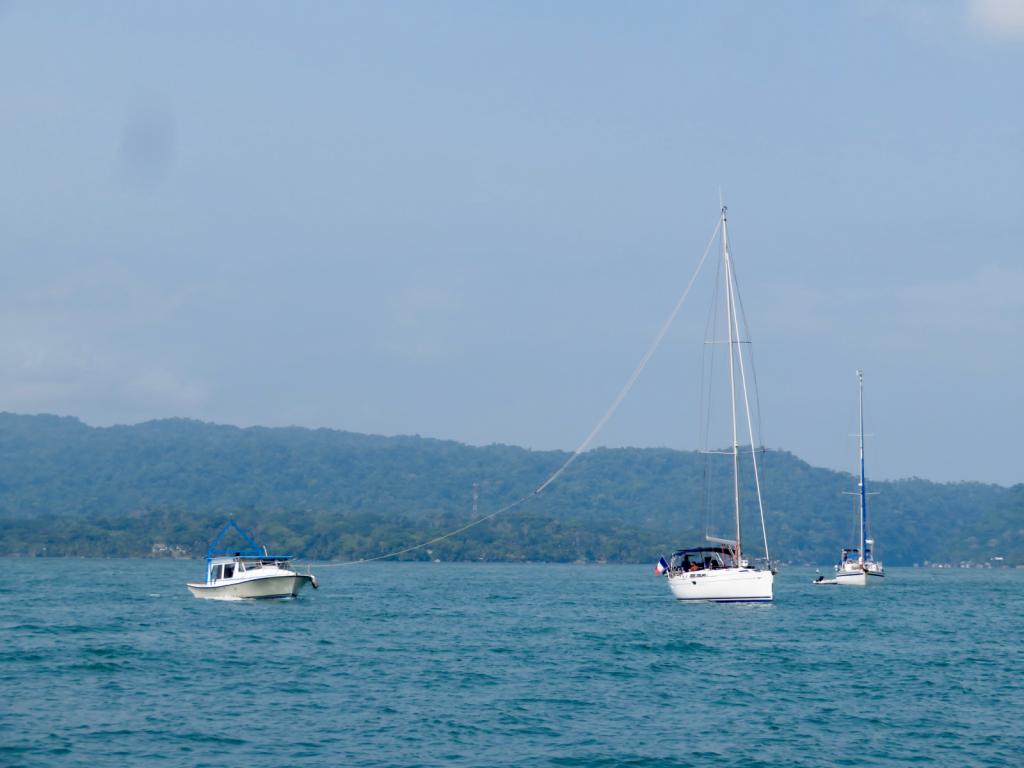
Second boat needed tipping. We watched the process. This boat however was ready for Hector. The lines were at the ready, exchanged, and wasn't long before the boat was canted over, moving along on a heel and then slowly the mast righted to normal straight up positions.
It was now close to one hour past posted high tide.
Then Hector came for the French boat with the 08:30 appointment. Having done this many times before, they were also ready, lines were exchanged. They needed tipping and towing, and they were pulled and heeled over for a ways before coming to a stop. Seriously stuck at an angle. The lines slackened, and then grew taut again, more heel, more pull. Time passed and it was frustrating all too far for us to see exactly what was going on, but slowly the boat moved over the sandbar, and eventually got righted as well.
In the meantime, Dave from SV Livin'Life dinghied over to visit with us.
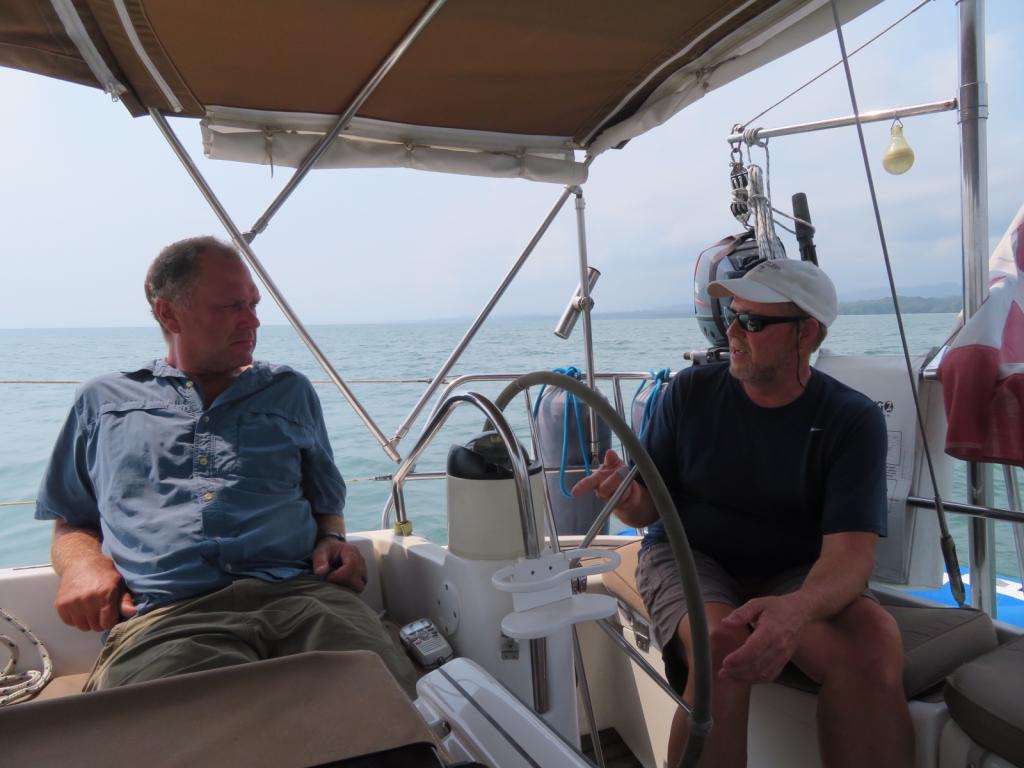
It was SO nice to have someone onboard to ease the anxiety of motoring around in circles, waiting for our turn.
And then at something past ten, one and a half hours later, one and a half hours past high tide, it was finally our turn. The Tow Boat arrived first, which we waved off with a smile and a "Gracias, no". Dave wanted to drive our own boat.

Then Hector arrived. We handed him the line we had prepped,
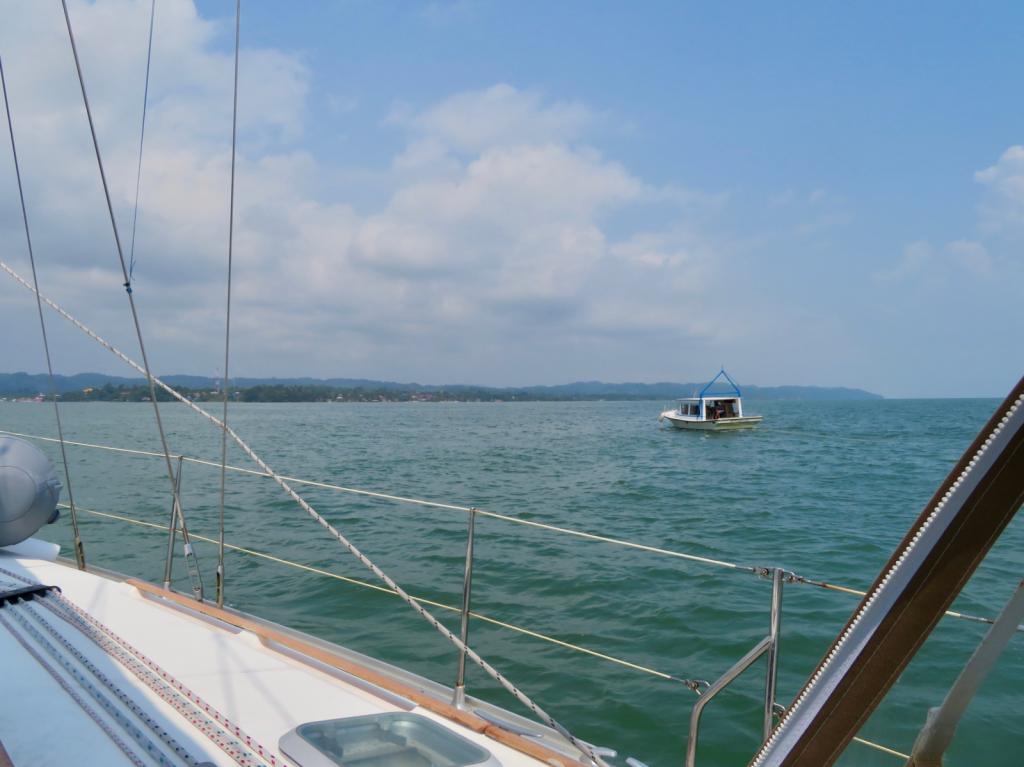
which he tied to his line, and once satisfied, slowly drove away from us. The line stretched as the distance between us grew, and with a series of hand signals between Hector and Dave, Banyan started to move, paralleling each other,
.jpeg)
ever so slowly,
.jpeg)
and surprisingly quite effortlessly. Then our life slanted to a heel,

although a controlled and maybe 15-20 degree heel, the rail just barely going into the water. It was all surprisingly quite civilized and comfortable. We've honestly heeled over more while sailing.
Then we felt the boat tremble ever so slightly as our keel touched bottom, shuddering as she bumpity-bump-bumped the sandy seabed floor. Dave put the revs on to keep us moving and gave a thumbs up gesture to Hector. Keep going.
In the distance we heard Hector rev his engine, we felt ourselves heel over a bit more. Dave revved us on as well, and I noticed our SOG reached 7 knots.
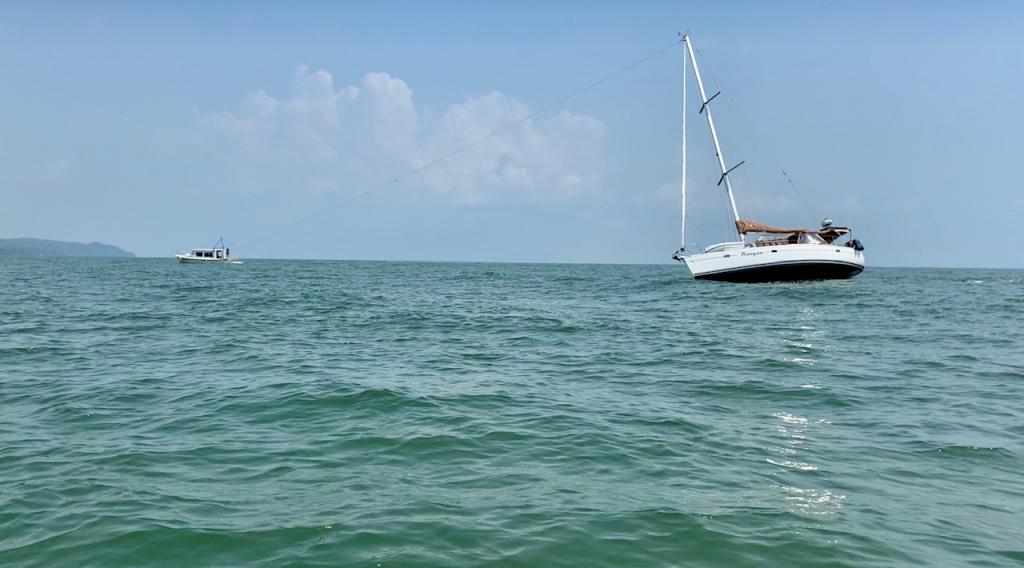
For a brief second our starboard rail touched the water, as the seabed sludgy sand no doubt rubbed the paint off our freshly painted keel. Then we felt ourselves come upright.
"I think we're through!" said Dave.
Although it felt like a lifetime, the whole tipping incident lasted a total of perhaps 12 minutes.
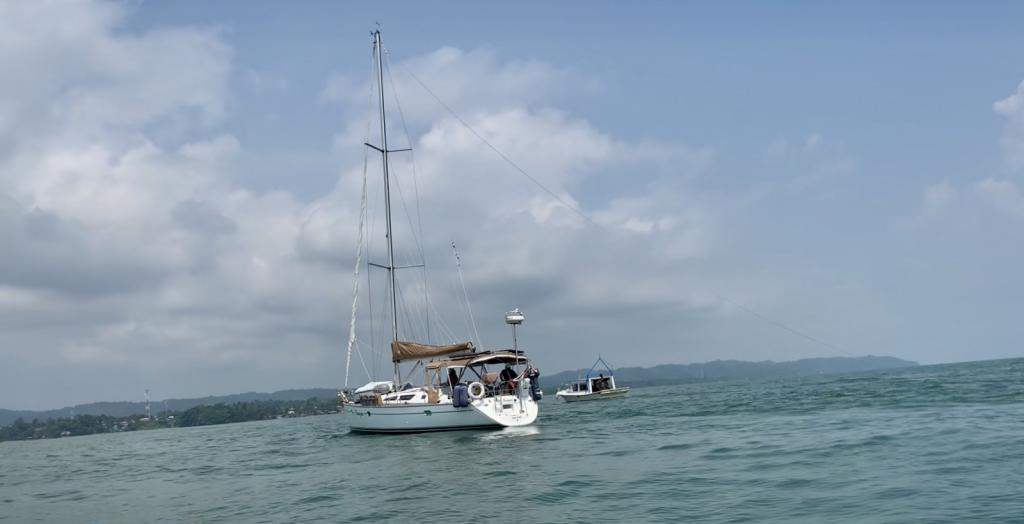
The lines were returned, the knots untied, and mere minutes later, we were dropping anchor in Livingston. We'd made it!!
Thanks Hector and Helper, y'all ROCK!
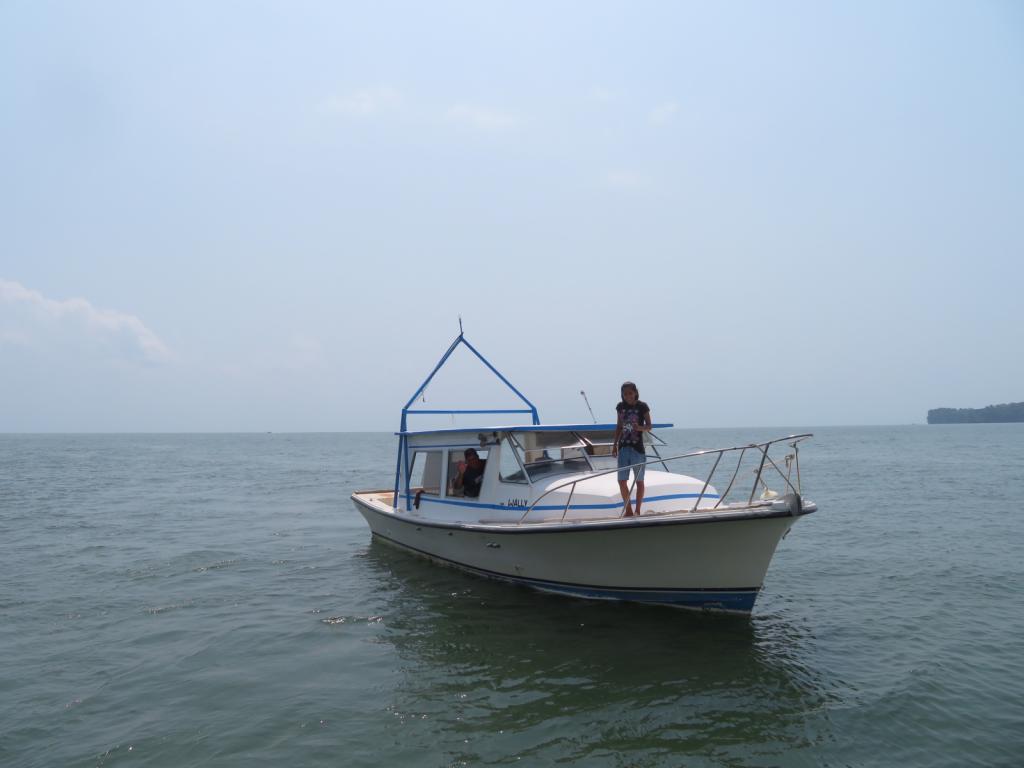
Thanks to David on David on Livin'Life for the photo ops.
And thanks to The Universe for the favourable conditions for the Crossing. The weather was great, the sea conditions were great, the people were great, and everything just fell into place.
We had our yellow Q-Flag hoisted and Raul and a boat load of officials came alongside, introduced themselves. We handed over copies of our paperwork, our Zarpe from Utila, our passports, and answered a few boat specific question. And then they told us to go ashore to their offices in about an hour's time to make payment and pick up our clearance papers.
.jpeg)
Hector came by, and we paid our tipping fee. And then it was time for Dave to go ashore. I stayed with the boat, which is a good thing as this area is notorious as a lousy anchorage. The wind was starting to pick up, the waters getting a little choppy, and the tidal currents were starting to play havoc with the anchored boats, some going in circles around their anchors, pointing every which way but where you would think they should. Livin'Life was having a hard go of it, and Janice needed to keep the engine running and revs on her boat, to keep it from getting too close to the other boats. With our dinghy on deck I felt powerless to do anything but watch, offer VHF support and a second set of eyes as boats circled around each other.
It felt like forever, but it was probably only an hour and Dave returned, paperwork in hand. We immediately weighed anchor and eagerly left the anchorage towards the entrance of the Rio Dulce River.
.jpeg)
The majestic heights of the lush mountains enveloping us on all sides as the voluminous area swallowed us.
.jpeg)
A canyon like fjord,
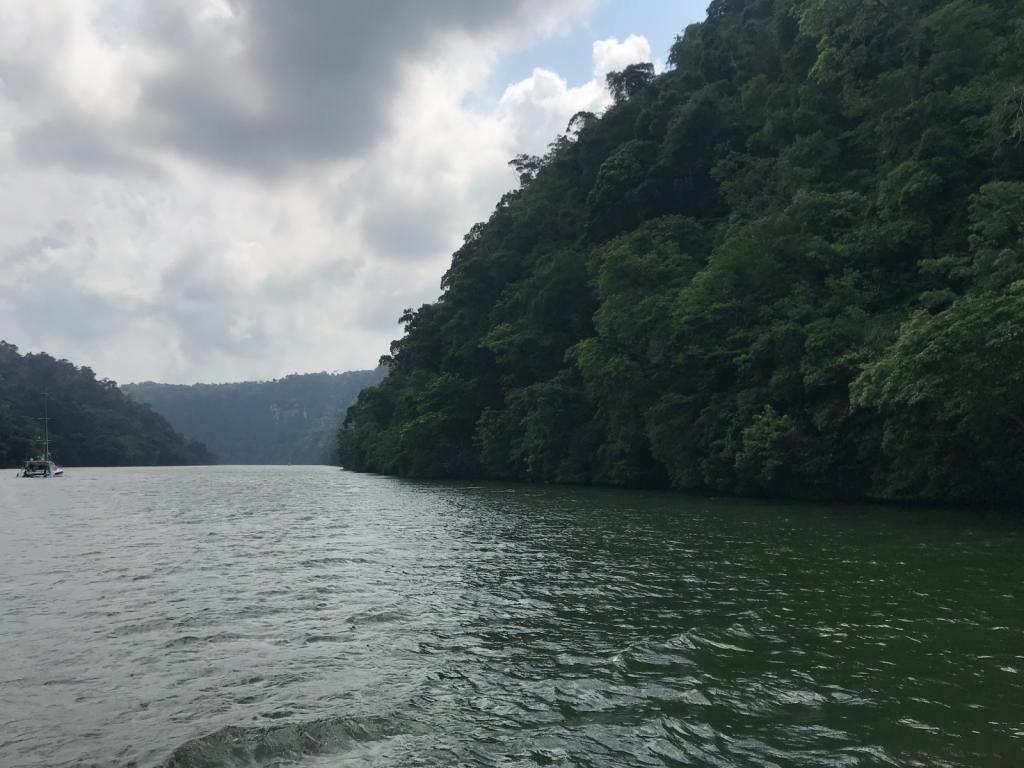
the views so incredibly, so absolutely and so overwhelmingly stunning, we were rendered absolutely speechless.

My eyes misted over.
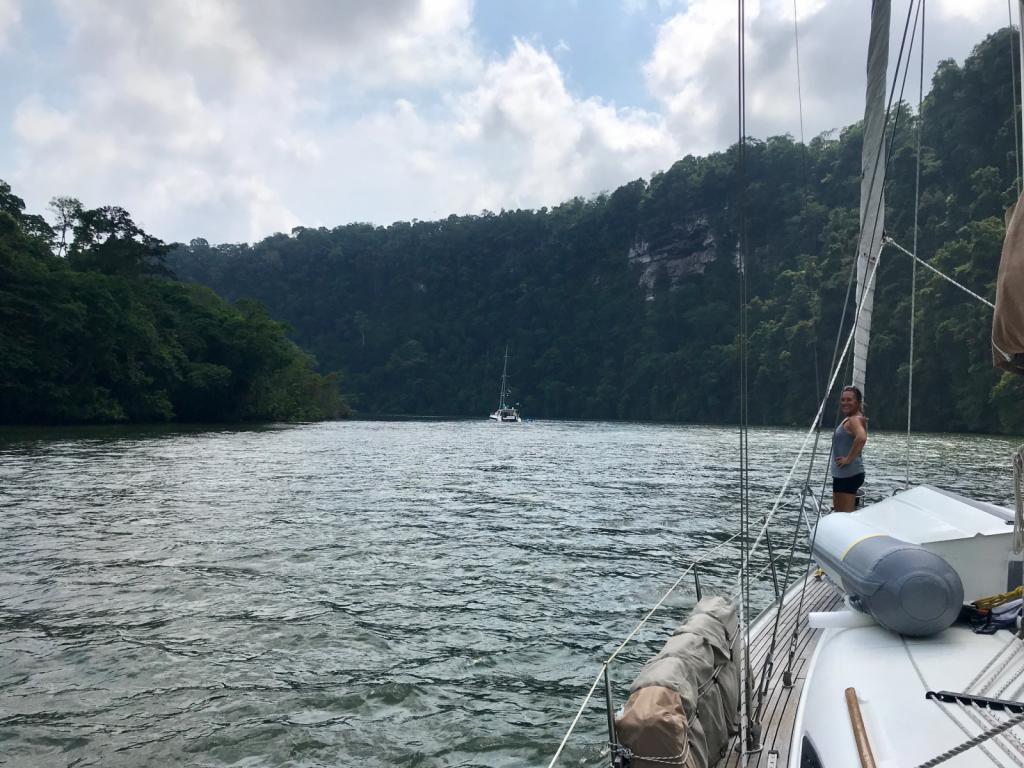
When you spend some time getting to a place, a trip fraught with adventure and challenges, a dream finally come true.
Tears of arrival joy, tears of relief. Tears of OhWOW.
.jpeg)
And that, my dear family, friends and fellow readers, is story of how Banyan crossed the shallowest of SandBars and entered the sweet Rio Dulce River,
.jpeg)
a long anticipated moment was now a memory that shall forevermore be known as The Great Big Tipping Incident.
Just before Livingston, where we would stop to clear in with Guatemalan Customs and Immigration, and just before the entrance to the Rio Dulce River, there exists the shallowest of a shifting sandbar. Crossing it with our 6'4" draft might be just a little... problematic.
"No Problem-Oh" said our friends, "there's people there who can tip you". Tip?
We looked at each other, squinting with eyes wide shut, with not quite a smile, and almost with a hint of a grimace. Being in and on your home while it's moving is one thing. Being in and on your home while it's moving, and being canted over while doing so, is not on anyone's comfort list. Challenging? You Bet. UnDoable? No, Many have gone before us, with Deeper Drafts than us, and survived to tell the tale! Nervous and Anxious? Hell yes!
We checked the Rio Dulce tide tables, looking for the dates for the highest of high tides happening in May.

Turns out May 18, 19 and 20th were our three days of options. On those dates we would have roughly, and at most, 1.9 feet of extra water over posted MLW depths. However, since the charts for this area were not all in agreement, {{so just how (in)accurate were they?? }}, we had no idea what we were dealing with. We chose May 19th as it listed the most water, until we looked at the calendar and realized that that day was a Sunday. A funday but not a working day. For C&I, or for Raul of Servamar and/or Hector Ramirez.
Our choices were then either Saturday or Monday and since a Sunday reunion with our friends in Tres Puntas was gathering momentum, we fixed our Big Crossing for Monday, 08:45 a.m. As much as no sailboat and cruiser ever wants to have a schedule, we now had ourselves {{ sigh }} a schedule. We had to get ourselves there for that date and time. What could possibly go wrong?
To bring you up to date: quite at the last minute we decided we would change course, so we got ourselves to Jamaica, on to Grand Cayman, then Ha!Ha! it was off to Guanaja! . On to Utila, and last but not least, we're in Tres Puntas.
So here we are.
It is Sunday night, the eve of the Big Crossing. A fun reunion on SV LivinLife allowed for much chit-chat and getting caught up, which is always an awesome time with friends, and that night it was no different. It also gave us the chance to meet many new cruisers.
As with all Sailing Stories, and especially Shallow Depth Crossing stories, listening to every one of them made us frown and feel like our depths made us a lost cause. Until we met a fellow Jeanneau owner, with a 7'something draft. "Pas de problèmes" he told us, "I've been crossing for the last few years and get tipped each and every time. I have an appointment at 08:30 with Hector. No worries mon ami, juste follow me", he said. Knowing someone was out there with more need to worry than us somehow spelled... relief.
Prior to this point we'd done as much research as we could. The facts of the crossing, as we knew them, were as follows:
There are no reliable charts for this area.
Mother Nature, climate and time have played havoc with the sandbar, making it quite the shifty piece of sand. So if, or rather when, you touch bottom, rumour has it that there is no need to worry. It really is just sludgy sand and chances are you will plow through it.
If, or rather when, you do bump bottom? Keep the revs on. You want and need speed and momentum to keep you going.
Weather is hard to predict months in advance so we didn't know what we were going to be experiencing the day of. If there's winds blowing, producing a 2 foot chop, well then chances are you'll bounce and hit even more than if conditions were calm. However, having wind might be a good thing, as it would allow you to out the jib, and produce a natural heel to aid in your crossing? Unlike the Bahamas, we didn't think the weather would be any shades of clear enough to spot and stay out of any shallow areas.
Water depths are dependant on time of year. How much has it rained recently? How active is the outflow of the Rio Dulce?
.png)
All reports are that it's an {{ easy }} bar crossing if you draw under 5.5. Anything over that should have you considering making the crossing at mid-to-high tide. We'd read that the maximum draft at high tide is 7.5 ft (2.20 m).
There is no marked channel, however there are few buoys out there. And there are several guiding waypoints floating around cyberspace.
Captain Freya Rauscher's waypoints are now, given time, weather and climate, considered old and rather inaccurate.
Different FB groups were providing some info, but one can never be sure, as some cruisers indicating "a no problem crossing" weren't providing any of their details (weather, tide, depth, draft...) which is always frustrating.
One boat had crossed the week prior and posted a new path with plenty of water depth. We were hopeful and intrigued.

Geoff on SV BlueJacket seemed to have spent quite some time with depth sounder in hand.
.png)
The whole event is only about 300-400 yards of unknown pucker factor conditions. That can seem like the longest {{ part of a }} mile though if you're bumping through it, or if you get stuck.
We had contacted Raul of Servamar to use as our agent for Guatemalan C&I procedures, and we'd e-mailed him our paperwork so he could start the process. At the same time, we made a request for Hector Ramirez to be on standby. We would try crossing on our own, but in all likelihood, would need some help of the heeling kind.
And last but not least, we had our friends. Who were going ahead of us, promising to read out the depths as they passaged through, providing much needed details of actual conditions.
It was a hot and hazy morning when we woke up the morning of the Big Crossing. We were well over a dozen boats in the Tres Puntas anchorage and we tried enjoying our coffee, but we were a little anxious and a lot excited.

It was a short 10 nmile motor boat drive from Tres Puntas towards Livingston and in our excitement we left earlier than planned {{besides you want to get there BEFORE high tide }}, and were there before we even thought about a second cup of coffee.
And one by one the boats made their way across, the VHF crackling to life as the numbers were read. Two boats were trying SV Follow Me's waypoints, and then immediately reported "NoGo!", as water depths reached 4'9. Yikes!

No matter which depths I wrote down, one thing quickly became clear: there was just not enough water. We could try and plow our way through with one inch of sandy sludge, but not 6!

The question we then asked ourselves was: do we try on our own? Get stuck, then really need to get not only tipped, but towed as well? Or wait by the first marker and just get tipped as we drive Banyan across. For us, given the conditions at this moment in time, that was the better, safer and most sound option.

Unfortunately one of the boats ahead of us had gone way off course and was now heeled over, totally stuck in the sand. We saw Hector on his way towards the 08:30 appointment with the French Boat which was two boats over from us? Oops no. Hector turned around and stopped at the stuck boat. Looked like a bit of chit-chat was going on, and we saw the people on the boat looking for lines, running around, getting set up, finally handing their lines over to Hector and the tow boat. It took a few tries, and well over half hour to get her freed and dragged across.
It was now half hour past high tide.

Second boat needed tipping. We watched the process. This boat however was ready for Hector. The lines were at the ready, exchanged, and wasn't long before the boat was canted over, moving along on a heel and then slowly the mast righted to normal straight up positions.
It was now close to one hour past posted high tide.
Then Hector came for the French boat with the 08:30 appointment. Having done this many times before, they were also ready, lines were exchanged. They needed tipping and towing, and they were pulled and heeled over for a ways before coming to a stop. Seriously stuck at an angle. The lines slackened, and then grew taut again, more heel, more pull. Time passed and it was frustrating all too far for us to see exactly what was going on, but slowly the boat moved over the sandbar, and eventually got righted as well.
In the meantime, Dave from SV Livin'Life dinghied over to visit with us.
It was SO nice to have someone onboard to ease the anxiety of motoring around in circles, waiting for our turn.
And then at something past ten, one and a half hours later, one and a half hours past high tide, it was finally our turn. The Tow Boat arrived first, which we waved off with a smile and a "Gracias, no". Dave wanted to drive our own boat.

Then Hector arrived. We handed him the line we had prepped,

which he tied to his line, and once satisfied, slowly drove away from us. The line stretched as the distance between us grew, and with a series of hand signals between Hector and Dave, Banyan started to move, paralleling each other,
.jpeg)
ever so slowly,
.jpeg)
and surprisingly quite effortlessly. Then our life slanted to a heel,

although a controlled and maybe 15-20 degree heel, the rail just barely going into the water. It was all surprisingly quite civilized and comfortable. We've honestly heeled over more while sailing.
Then we felt the boat tremble ever so slightly as our keel touched bottom, shuddering as she bumpity-bump-bumped the sandy seabed floor. Dave put the revs on to keep us moving and gave a thumbs up gesture to Hector. Keep going.
In the distance we heard Hector rev his engine, we felt ourselves heel over a bit more. Dave revved us on as well, and I noticed our SOG reached 7 knots.

For a brief second our starboard rail touched the water, as the seabed sludgy sand no doubt rubbed the paint off our freshly painted keel. Then we felt ourselves come upright.
"I think we're through!" said Dave.
Although it felt like a lifetime, the whole tipping incident lasted a total of perhaps 12 minutes.

The lines were returned, the knots untied, and mere minutes later, we were dropping anchor in Livingston. We'd made it!!
Thanks Hector and Helper, y'all ROCK!
Thanks to David on David on Livin'Life for the photo ops.
And thanks to The Universe for the favourable conditions for the Crossing. The weather was great, the sea conditions were great, the people were great, and everything just fell into place.
We had our yellow Q-Flag hoisted and Raul and a boat load of officials came alongside, introduced themselves. We handed over copies of our paperwork, our Zarpe from Utila, our passports, and answered a few boat specific question. And then they told us to go ashore to their offices in about an hour's time to make payment and pick up our clearance papers.
.jpeg)
Hector came by, and we paid our tipping fee. And then it was time for Dave to go ashore. I stayed with the boat, which is a good thing as this area is notorious as a lousy anchorage. The wind was starting to pick up, the waters getting a little choppy, and the tidal currents were starting to play havoc with the anchored boats, some going in circles around their anchors, pointing every which way but where you would think they should. Livin'Life was having a hard go of it, and Janice needed to keep the engine running and revs on her boat, to keep it from getting too close to the other boats. With our dinghy on deck I felt powerless to do anything but watch, offer VHF support and a second set of eyes as boats circled around each other.
It felt like forever, but it was probably only an hour and Dave returned, paperwork in hand. We immediately weighed anchor and eagerly left the anchorage towards the entrance of the Rio Dulce River.
.jpeg)
The majestic heights of the lush mountains enveloping us on all sides as the voluminous area swallowed us.
.jpeg)
A canyon like fjord,
the views so incredibly, so absolutely and so overwhelmingly stunning, we were rendered absolutely speechless.
My eyes misted over.

When you spend some time getting to a place, a trip fraught with adventure and challenges, a dream finally come true.
Tears of arrival joy, tears of relief. Tears of OhWOW.
.jpeg)
And that, my dear family, friends and fellow readers, is story of how Banyan crossed the shallowest of SandBars and entered the sweet Rio Dulce River,
.jpeg)
a long anticipated moment was now a memory that shall forevermore be known as The Great Big Tipping Incident.
Comments
| Vessel Name: | Banyan |
| Vessel Make/Model: | Jeanneau 40 Sun Odyssey |
| Hailing Port: | Halifax, Nova Scotia |
| Crew: | David & Alexandra |
| About: | |
| Extra: | CHART YOUR COURSE: Our destiny is shaped by our thoughts and actions. We cannot direct the wind but we can adjust the sails. |
| Social: |
The Adventures of Alexandra and David

Who: David & Alexandra
Port: Halifax, Nova Scotia
Our Adventures Thus Far
Favorites
- Author - Rob Avery
- Amoray
- AnneCam
- Distant Shores
- Evening Ebb
- Harmony at Sea
- Jacobs Ladder
- Kathrian
- Lequesteau
- Modaki
- Sea Sparrow
- Shiloh
- Slow Waltz
- Spirit of Argo
- Strathspey
- SV Mowzer
- Troubador
- Turf to Surf
- Wandering Star
- Dos Libras
- Pacific Sailors
- Zero to Cruising
- BUMFUZZLE
- Madcap Sailing
- Silverheels lll
- Peregrine
- Windtraveler
We're always Somewhere South of Somewhere.
The Banyan Love is Growing.

WebPage Visits We're on Facebook Sailing Banyan

Instagram: #banyantravels but we're not Tweeting. Our friends Paul and Sheryl Shard, of Distant Shores, are incredible producers of their very own TV Show. If you haven't already, check them out. Their DVD's are informative and fun to watch as they travel to all four corners of the world.
You might even find Banyan in some of them!!
Their DVD's are informative and fun to watch as they travel to all four corners of the world.
You might even find Banyan in some of them!!
WebPage Visits We're on Facebook Sailing Banyan

Instagram: #banyantravels but we're not Tweeting. Our friends Paul and Sheryl Shard, of Distant Shores, are incredible producers of their very own TV Show. If you haven't already, check them out.
 Their DVD's are informative and fun to watch as they travel to all four corners of the world.
You might even find Banyan in some of them!!
Their DVD's are informative and fun to watch as they travel to all four corners of the world.
You might even find Banyan in some of them!! 
